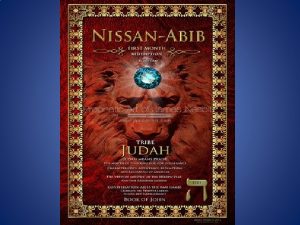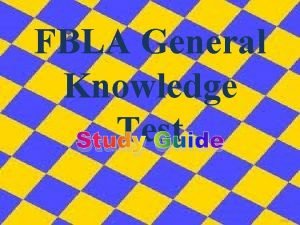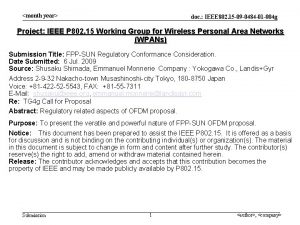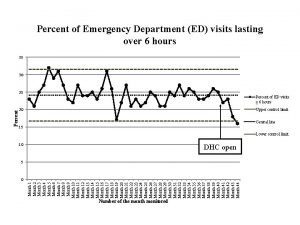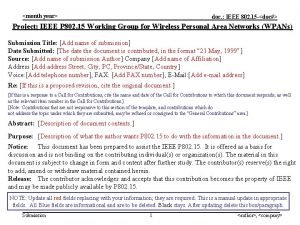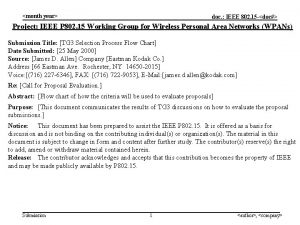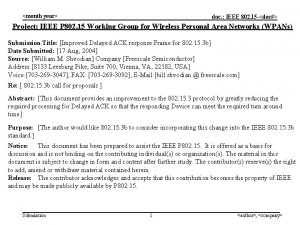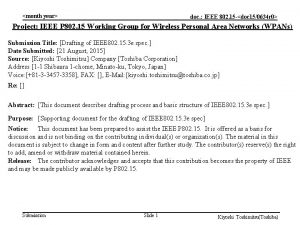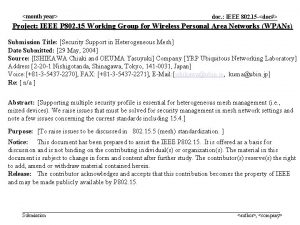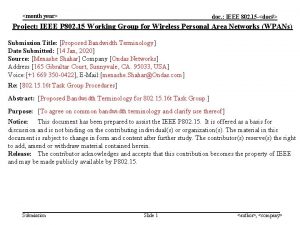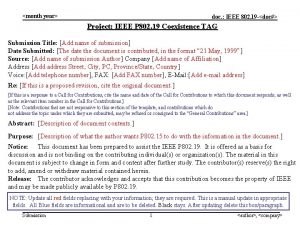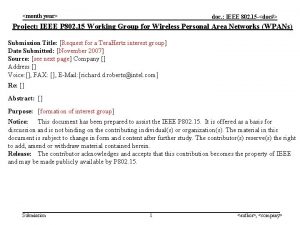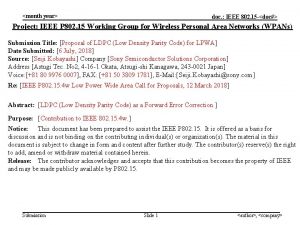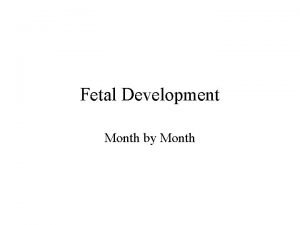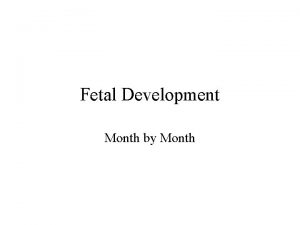month year doc IEEE 802 15 09 0484















- Slides: 15

<month year> doc. : IEEE 802. 15 -09 -0484 -02 -004 g Project: IEEE P 802. 15 Working Group for Wireless Personal Area Networks (WPANs) Submission Title: FPP-SUN Regulatory Conformance Consideration. Date Submitted: 6 Jul. 2009 Source: Shusaku Shimada, Emmanuel Monnerie Company : Yokogawa Co. , Landis+Gyr Address 2 -9 -32 Nakacho-town Musashinoshi-city Tokyo, 180 -8750 Japan Voice: +81 -422 -52 -5543, FAX: +81 -55 -7311 E-Mail: shusaku@ieee. org, emmanuel. monnerie@landisgyr. com Re: TG 4 g Call for Proposal Abstract: Regulatory related aspects of OFDM proposal. Purpose: To present the versatile and powerful nature of FPP-SUN OFDM proposal. Notice: This document has been prepared to assist the IEEE P 802. 15. It is offered as a basis for discussion and is not binding on the contributing individual(s) or organization(s). The material in this document is subject to change in form and content after further study. The contributor(s) reserve(s) the right to add, amend or withdraw material contained herein. Release: The contributor acknowledges and accepts that this contribution becomes the property of IEEE and may be made publicly available by P 802. 15. Submission 1 <author>, <company>

<month year> doc. : IEEE 802. 15 -09 -0484 -02 -004 g Summary (1) Background: Flexible and dynamic frequency spectrum utilization is an institutional trend in each jurisdictional regions and ITU-R. (2) Frequency availability around the world should keep being added or altered by each regulatory authorities continuously after now. (3) 700 MHz-1 GHz spectrum will keep containing similar and useful, but simultaneously diverse global bands for SUN application even in the future. (4) Possible scalable Data Rate and Bandwidth of OFDM have to be instrumental for future adaptation of novel frequency availability, and for the legacy interference avoidance even in case of migration from NBFH systems. Contributors: Roberto Aiello [Independent], Sangsung Choi [ETRI], Bob Fishette [Trilliant], David Howard [On-Ramp], Rishi Mohindra [MAXIM], Emmanuel Monnerie [Landis & Gyr], Partha Murali [Redpine Signal], Steve Shearer [Independent], Shusaku Shimada [Yokogawa Electric Co. ], Kendall Smith [Aclara] Xing Tao [Chinese Academic of Science], Betty Zhao [Huawei] Submission 2 <author>, <company>

February 2007 doc. : IEEE 802. 15 -09 -0484 -02 -004 g IEEE 802. 15. 4 g PAR : Scope • • • This Standard defines an amendment to IEEE 802. 15. 4. It addresses principally outdoor Low Data Rate Wireless Smart Metering Utility Network requirements. It defines an alternate PHY and only those MAC modifications needed to support its implementation. Specifically, the amendment supports all of the following: – – – – • Operation in any of the regionally available license exempt frequency bands, such as 700 MHz to 1 GHz, and the 2. 4 GHz band. Data rate of at least 40 kbps but not more than 1000 kbps. Achieve the optimal energy efficient link margin given the environmental conditions encountered in Smart Metering deployments. Principally outdoor communications PHY frame sizes up to a minimum of 1500 octets Simultaneous operation for at least 3 co-located orthogonal networks Connectivity to at least one thousand direct neighbors characteristic of dense urban deployment. Provides mechanisms that enable coexistence with other systems in the same band(s) including IEEE 802. 11, 802. 15 and 802. 16 systems. Submission 3 Shusaku Shimada, Yokogawa Co.

February 2007 doc. : IEEE 802. 15 -09 -0484 -02 -004 g IEEE 802. 15. 4 g PAR:Purposes and Needs • Purpose: • Need for the Project: – To provide a global standard that facilitates very large scale process control applications such as the utility smart-grid network. This amendment supports large, geographically diverse networks with minimal infrastructure. – Smart Metering Utility Networks can potentially contain millions of fixed endpoints. – The communication range, robustness, and coexistence characteristics required for this class of application have not been met with existing 802 standards. – The need for a standard to promote orderly and quick evolution of smart-grid networks has been recognized in the recently passed energy legislation by the U. S. Congress (EISA 2007; Energy Independence & Security Act of 2007), which calls on National Institute of Standards and Technology (NIST) to work with standards bodies (such as IEEE) to develop protocols and standards for the smart-grid network. In the European. Union, the need is no less urgent and similar standardization mandates, such as the EU's 20/20/20 plan, are in process worldwide. – The responses received by and presented to the 15. 4 g Study Group indicate an already large and rapidly growing market for wireless Smart Metering applications that fit the objectives of 802. 15, but are not satisfied by existing IEEE 802 standards. – Utility networking and very large scale industrial applications have requirements to keep infrastructure to a minimum, scale to millions of nodes across diverse geographical environments, and do so with carrier grade reliability. To reach every node in the network a Wireless Smart Metering Utility Network needs the capability to vary radio range while providing for high spectral reuse. Submission 4 Shusaku Shimada, Yokogawa Co.

February 2007 doc. : IEEE 802. 15 -09 -0484 -02 -004 g Outdoor, Reliability and Battery Operation Outdoor : Simple to use ・ Adequate coverage area and sufficient one hop reach. - Good propagation characteristics - Resulting frequency reuse within the mesh or over the cells. ・ License exempt, light licensing or professional installation. Battery Operation Reliability ・ Long battery life ・ Separation from 2. 4 GHz band - Low power LSI integration entertainment gadgets. ・ Quick operation : ・ High sensitivity & link margin. - Frame-Tx, Rx, CCA & everything ・ Diversity : ・ Energy saving protocol - Frequency, time & space OFDM and 700 MHz-1 GHz band deserve Submission 5 Shusaku Shimada, Yokogawa Co.

February 2007 doc. : IEEE 802. 15 -09 -0484 -02 -004 g Regulatory Conformance Table of OFDM proposal Submission 6 Shusaku Shimada, Yokogawa Co.

<month year> doc. : IEEE 802. 15 -09 -0484 -02 -004 g Regulatory Conformance Table for 700 MHz-1 GHz Submission 7 <author>, <company>

<month year> doc. : IEEE 802. 15 -09 -0484 -02 -004 g Other Lower Frequency Bands Other frequency bands may be possible to incorporate; (1) If their regulatory endorsement and required capacity and bandwidth regarding SUN application stands, (2) If “too good” propagating characteristics of diffraction and sporadic reflection and refraction effect no extra co-channel interference issues in term of cellular or Mesh architecture, OFDM scheme is well proven by several terrestrial broadcasting standards and services globally. Submission 8 <author>, <company>

<month year> doc. : IEEE 802. 15 -09 -0484 -02 -004 g Scalable Data Rates / Bandwidth by OFDM Flexibility to forge the signal required in each region and/or band Foster a global viable market justifing the cutting edge LSI by 15. 4 g Submission 9 <author>, <company>

February 2007 doc. : IEEE 802. 15 -09 -0484 -02 -004 g Modulation Bandwidth adaptation Excerpt from the simulation results carried out by Rishi Mohindra, MAXIM Integrated Products TX Power, Out of Band Spectrum Mask, Spurious Emission Requirement Number of sub-carriers incorporated, PA-backoff, Windowing Parameters Submission 10 Shusaku Shimada, Yokogawa Co.

February 2007 doc. : IEEE 802. 15 -09 -0484 -02 -004 g Example : ERC 868 MHz Mask (Europe) • +13 d. Bm output power • PA = Rapps model with Rho = 3 Excerpt from the simulation results carried out by Rishi Mohindra, MAXIM Integrated Products Submission 11 Shusaku Shimada, Yokogawa Co.

February 2007 doc. : IEEE 802. 15 -09 -0484 -02 -004 g Example: ARIB T-96 Mask (Japan) Excerpt from the simulation results carried out by Rishi Mohindra, MAXIM Integrated Products Submission 12 Shusaku Shimada, Yokogawa Co.

<month year> doc. : IEEE 802. 15 -09 -0484 -02 -004 g Example: 2. 4 GHz Ristricted Band Compliance (US) 500 KHz BW OFDM with 30 d. Bm TX power • • • Rapps PA model. 6 d. B back off from saturation power for PA, rho = 1. At 2400. 5 MHz channel, meets requirement for 2390 MHz restricted band (10 MHz from carrier). At 2477 MHz channel, meets requirement for 2483 MHz restricted band (6 MHz offset from carrier). Excerpt from the simulation results carried out by Rishi Mohindra, MAXIM Integrated Products Submission 13 <author>, <company>

February 2007 doc. : IEEE 802. 15 -09 -0484 -02 -004 g Advantage of OFDM for Regulatory Conformance • • OFDM Proposal includes signal bandwidth of - International ISM 2. 4 GHz 68 k. Hz, 146 k. Hz, 264 k. Hz, 518 k. Hz and 1. 06 MHz. • OFDM Proposal covers every frequency bands of, - US 915 MHz - Europe 863 -870 MHz OFDM Proposal provides data rates of - Japanese 950 MHz - Chinese 783 MHz 46 kbps to 781 kbps - Korean 922 MHz • OFDM proposal consistently maintains - TV White Space - 9765. 63 Hz tone spacing - 128 us symbol duration. Flexibility of OFDM works even if future availability of SUN frequency bands are altered and increased. Submission 14 Shusaku Shimada, Yokogawa Co.

February 2007 doc. : IEEE 802. 15 -09 -0484 -02 -004 g References TG 4 g PAR 15 -09 -0114 -00 -004 g Emmanuel Monnerie (Landis+Gyr) 15 -09 -0126 -00 -004 g Steve Shearer (self) 15 -09 -0275 -02 -004 g Sangsung Choi , Cheolho Shin and Byounghak Kim(ETRI) 15 -09 -0279 -00 -004 g G. Flammer (SSN), E. Monnerie (L+G), S. Shearer, S. Shimada (Yokogawa Electric Corp. ) 15 -09 -0289 -01 -004 g/15 -09 -0294 -02 -004 g Steve Shearer (self) 15 -09 -0291 -00 -004 g Emmanuel Monnerie (Landis+Gyr) 15 -09 -0293 -03 -004 g Rishi Mohindra (MAXIM) 15 -09 -0453 -01 -004 g-guidance-t 15 -09 -0175 -01 -004 g-european-regularity-considerations. ppt 15 -09 -0453 -01 -004 g-guidance-to-phy-band-adaptation. doc 15 -09 -0189 -00 -004 g-korean-regulatory-considerations. ppt 15 -09 -0476 -00 -004 g-phy-layer-discussion-for-chinese-nb-bands. ppt 15 -09 -0382 -00 -004 g-sun-perspectives-from-epri. ppt 15 -08 -0109 -02 -004 d-WW-BPSK-with-AFA-provisioning. pdf Submission 15 Shusaku Shimada, Yokogawa Co.
 Bridges from 802.x to 802.y
Bridges from 802.x to 802.y Bridges from 802.x to 802.y
Bridges from 802.x to 802.y Ieee 802 3 compliance
Ieee 802 3 compliance Ieee802.22
Ieee802.22 Arquitetura ieee 802
Arquitetura ieee 802 Norma ieee 802
Norma ieee 802 Ieee 802 standard
Ieee 802 standard Bluetooth ieee 802
Bluetooth ieee 802 802 ieee
802 ieee Ieee 802
Ieee 802 Ieee 802 family
Ieee 802 family Synodic month vs sidereal month
Synodic month vs sidereal month Abib and nisan
Abib and nisan Favorite month of the year
Favorite month of the year Where was the first fbla chapter located
Where was the first fbla chapter located Year 6 leavers poem
Year 6 leavers poem












